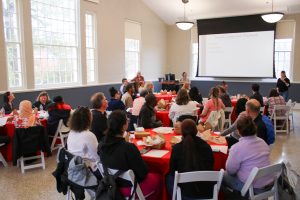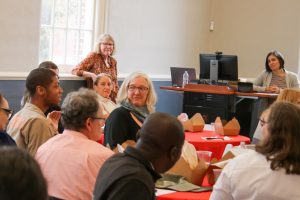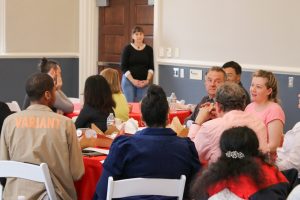by Derek Bruff, visiting associate director
 Last Friday, CETL hosted the third event in our STEM teaching lunch series. This conversation was focused on student belonging with a presentation by Rebecca Symula, instructional associate professor of biology; Susan Pedigo, professor of chemistry and biochemistry; and Jessica Osborne, principal evaluation associate at the Center for Research Evaluation (CERE). The presenters are all part of a grant from the Howard Hughes Medical Institute (HHMI) to understand, promote, and evaluate inclusivity in STEM education.
Last Friday, CETL hosted the third event in our STEM teaching lunch series. This conversation was focused on student belonging with a presentation by Rebecca Symula, instructional associate professor of biology; Susan Pedigo, professor of chemistry and biochemistry; and Jessica Osborne, principal evaluation associate at the Center for Research Evaluation (CERE). The presenters are all part of a grant from the Howard Hughes Medical Institute (HHMI) to understand, promote, and evaluate inclusivity in STEM education.
As part of the grant work, Jessica and her CERE colleagues conducted focus groups with undergraduate students using a World Cafe approach and surveyed STEM faculty members to get a better understanding of student belonging and the actions that can foster it. At the Friday lunch, Jessica shared some of the results of that research while Rebecca and Susan connected those results to their individual teaching practices and invited discussion among the faculty, staff, and graduate students in attendance.
 What is student belonging? Rebecca Symula shared a definition from researcher Terrell Strayhorn: “Sense of belonging is a basic human need, and at the most basic level, is whether or not a person feels respected, valued, accepted, cared for, and included.” I’ve often cited the research of Geoffrey Cohen who studies belonging in education, and in a recent interview he described belonging as simply the sense that we are a valued part of a community. Cohen has a new book out called Belonging: The Science of Creating Connections and Bridging Divides, and it’s on my desk ready for me to read soon! There’s also a model developed by Zumbrunn et al. (2014) specifically for science education which situates belonging as a pre-condition for self-efficacy in a course and a valuing of course tasks, both of which in turn lead to motivation to learn and the development of a science identity.
What is student belonging? Rebecca Symula shared a definition from researcher Terrell Strayhorn: “Sense of belonging is a basic human need, and at the most basic level, is whether or not a person feels respected, valued, accepted, cared for, and included.” I’ve often cited the research of Geoffrey Cohen who studies belonging in education, and in a recent interview he described belonging as simply the sense that we are a valued part of a community. Cohen has a new book out called Belonging: The Science of Creating Connections and Bridging Divides, and it’s on my desk ready for me to read soon! There’s also a model developed by Zumbrunn et al. (2014) specifically for science education which situates belonging as a pre-condition for self-efficacy in a course and a valuing of course tasks, both of which in turn lead to motivation to learn and the development of a science identity.
During the presentation, Jessica shared a few instructor behaviors that were identified by study participants to help foster belonging, including opening up the class to discussion, encouraging students to help each other, sharing what’s happening in the department, and providing consistent due dates and reminders. She asked those of us in the audience to guess whether each behavior was identified by a student participant or a faculty participant, and we generally got the answers wrong! Jessica made the point that there’s a lot of overlap between what students and faculty say about fostering belonging, which our guesses demonstrated in a way.
 From the list of instructional approaches identified by study participants as fostering belonging, we drilled down on a couple of practices during the discussion. Knowing student names was a hot topic because it helps students feel valued and encourages them to seek help (Cooper et al., 2017), but it’s hard to pull off practically, especially if you have more than 20 or 30 students. CETL director Josh Eyler pointed out that using student names what matters, not memorizing student names, which means that having students use name tents during class can help with belonging. I have a standard discussion rule that the first time someone speaks up in class they should introduce themselves, which is another way to actively use student names. There was also a recent graduate in the room who added that names aren’t entirely necessary; just recognizing a student you pass on the sidewalk as one of your students can help that student feel they have a place at the university.
From the list of instructional approaches identified by study participants as fostering belonging, we drilled down on a couple of practices during the discussion. Knowing student names was a hot topic because it helps students feel valued and encourages them to seek help (Cooper et al., 2017), but it’s hard to pull off practically, especially if you have more than 20 or 30 students. CETL director Josh Eyler pointed out that using student names what matters, not memorizing student names, which means that having students use name tents during class can help with belonging. I have a standard discussion rule that the first time someone speaks up in class they should introduce themselves, which is another way to actively use student names. There was also a recent graduate in the room who added that names aren’t entirely necessary; just recognizing a student you pass on the sidewalk as one of your students can help that student feel they have a place at the university.
We also talked about what I like to call “first week of class work,” that is, what we say in our syllabi and how we talk about our courses to students early in the semester. Students are more likely to see instructors as approachable when instructors use warm and welcoming language in these settings (Hamish and Bridges, 2011). Susan Pedigo mentioned that her syllabus used to read like a legal contract, but as she’s learned more about this line of research, she’s adopted a much more invitational tone in her course documents. Other lunch participants talked about the importance of helping students understand what they’re likely to get out of a course so that they see value in participating actively in the course. And I’ll recommend a resource I just learned about today, a “Who’s in class?” form developed by educational developer Tracie Addy and colleagues that’s useful for learning about your students and also communicating to them that you care about them as people and as learners.
 One topic we didn’t dive into was the ways that students’ social identities (gender, race, first-generation status, neurodivergence, and so on) can affect their sense of belonging. This is a big topic and an important one, and I hope we’ll explore it at a future STEM teaching lunch. For now, I’ll point to some of Geoffrey Cohen’s research showing that a relatively brief intervention can have lasting effects on college student success. The intervention helped students see that worries about belonging are normal and tend to improve over time, and just thirty minutes of this was enough to improve first-year completion rates by two percentage points for students in groups that historically persist at lower rates. Using students’ names and adopting a welcome tone the first week of class are useful moves to make, but there are many more strategies instructors can leverage to help students develop a sense of belonging.
One topic we didn’t dive into was the ways that students’ social identities (gender, race, first-generation status, neurodivergence, and so on) can affect their sense of belonging. This is a big topic and an important one, and I hope we’ll explore it at a future STEM teaching lunch. For now, I’ll point to some of Geoffrey Cohen’s research showing that a relatively brief intervention can have lasting effects on college student success. The intervention helped students see that worries about belonging are normal and tend to improve over time, and just thirty minutes of this was enough to improve first-year completion rates by two percentage points for students in groups that historically persist at lower rates. Using students’ names and adopting a welcome tone the first week of class are useful moves to make, but there are many more strategies instructors can leverage to help students develop a sense of belonging.
Thanks to our presenters and to all of those who came and participated in the discussion. And stay tuned to the usual CETL channels to hear about our spring semester slate of STEM teaching lunches.

 Earlier this week, CETL and AIG hosted a discussion among UM faculty and other instructors about teaching and AI this fall semester. We wanted to know what was working when it came to policies and assignments that responded to generative AI technologies like ChatGPT, Google Bard, Midjourney, DALL-E, and more. We were also interested in hearing what wasn’t working, as well as questions and concerns that the university community had about teaching and AI.
Earlier this week, CETL and AIG hosted a discussion among UM faculty and other instructors about teaching and AI this fall semester. We wanted to know what was working when it came to policies and assignments that responded to generative AI technologies like ChatGPT, Google Bard, Midjourney, DALL-E, and more. We were also interested in hearing what wasn’t working, as well as questions and concerns that the university community had about teaching and AI.